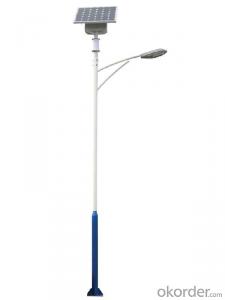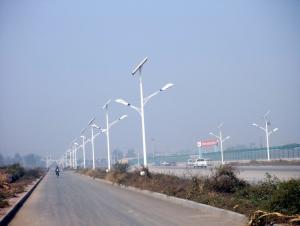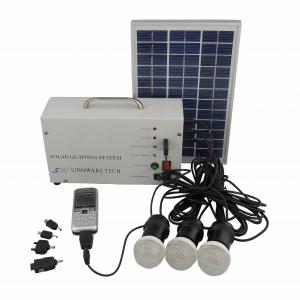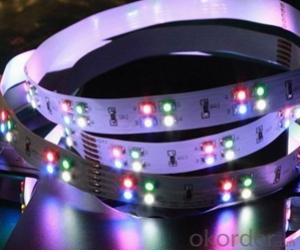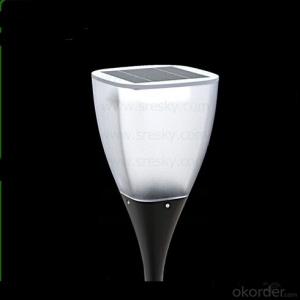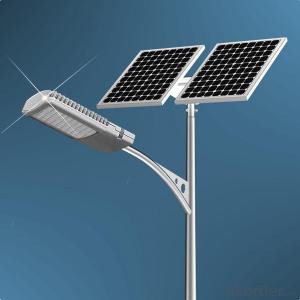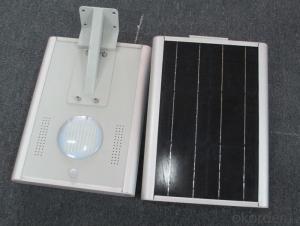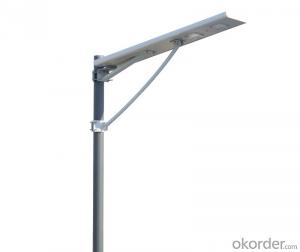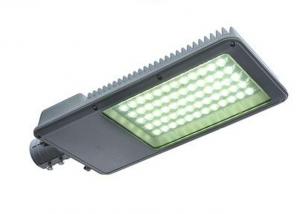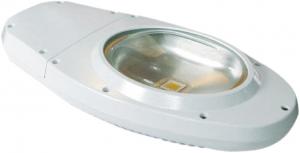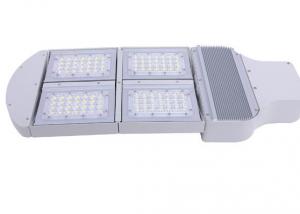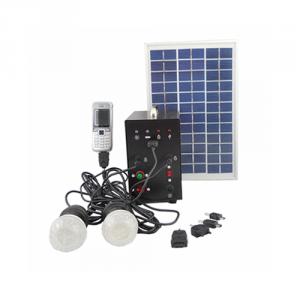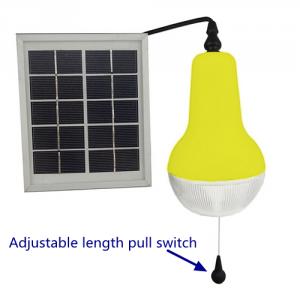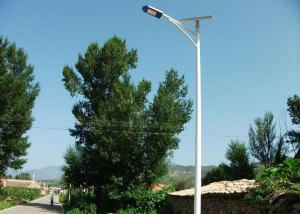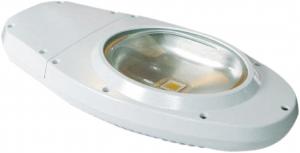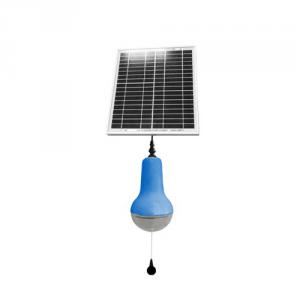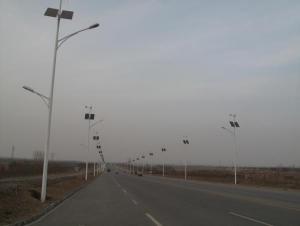Solar Light Solar Product Off Grid New Energy 027ZE
- Loading Port:
- Shanghai
- Payment Terms:
- TT OR LC
- Min Order Qty:
- 1 watt
- Supply Capability:
- 5000 watt/month
OKorder Service Pledge
OKorder Financial Service
You Might Also Like
1, Product desciption
Inverter circuits designed to produce a variable output voltage range are often used within motor speed controllers.
The DC power for the inverter section can be derived from a normal AC wall outlet or some other source. Control and feedback circuitry is used to adjust the final output of the inverter section which will ultimately determine the speed of the motor operating under its mechanical load.
Motor speed control needs are numerous and include things like: industrial motor driven equipment, electric vehicles, rail transport systems, and power tools. (See related: variable-frequency drive ) Switching states are developed for positive, negative and zero voltages as per the patterns given in the switching Table.
The generated gate pulses are given to each switch in accordance with the developed pattern and thus the output is obtained.
Solar power is energy from the sun. "Solar" is the Latin word for "sun" and
And Powerful source of energy. Without it, there will be no life.
Solar energy is considered as a serious source of energy for many years
of the vast amounts of energy that is made freely available, if harnessed by modern technology.
A magnifying glass can be used to heat up a small amount of water.
The short piece of copper tube is sealed at one end and filled with water.
And magnifying glass is then used to warm up the pipe.
Using more than one magnifying glass will increase the temperature more rapidly.
2, Features of the product
Inverters convert low frequency main AC power to higher frequency for use in induction heating.
To do this, AC power is first rectified to provide DC power. The inverter then changes the DC power to high frequency AC power. Due to the reduction in the number of DC Sources employed, the structure becomes more reliable and the output voltage has higher resolution due to an increase in the number of steps so that the reference sinusoidal voltage can be better achieved.
This configuration has recently become very popular in AC power supply and adjustable speed drive applications. This new inverter can avoid extra clamping diodes or voltage balancing capacitors. There are three kinds of level shifted modulation techniques, namely: 1,High and stable conversion efficienly based on over 4 years professional experience
2 ,High reliability with guaranteed +/-10% output power tolerance
3,Proven materials,tempered front glass,and a sturdy anodized aluminum frame allow modules to operate reliably in multiple mountily configurations
4,Combination of high efficicncy and attractive appearance
The first thing to figure out is the length of road in need of street lights.
This can be a small entrance road only a couple hundred of feet long to miles of streets through an area. Does the area currently have any type of lighting available.
What is the reason for needing street lights in this area
Is the electrical grid already nearby or would you need to call in the power company to bring in electrical lines.
If the electric needs to be brought to the area, how much is this going to cost? Depending on how far the grid electric is from the location of the needed lighting, this can be quite expensive.
How much lighting is needed on the street? Do the lights need to be dark sky compliant.
Do the street lights need to run from dusk to dawn or for only a specified number of hours at night.
Are the street lights able to dim in the middle of the night and still provide enough lighting.
These questions need to be answered before you can decide on how many lights you will need to complete the project.
Grid-tie inverters that are available on the market today use a number of different technologies. The inverters may use the newer high-frequency transformers, conventional low-frequency transformers, or no transformer. Instead of converting direct current directly to 120 or 240 volts AC, high-frequency transformers employ a computerized multi-step process that involves converting the power to high-frequency AC and then back to DC and then to the final AC output voltage.
Historically, there have been concerns about having transformerless electrical systems feed into the public utility grid. The concerns stem from the fact that there is a lack of galvanic isolation between the DC and AC circuits, which could allow the passage of dangerous DC faults to be transmitted to the AC side. Since 2005, the NFPA's NEC allows transformerless (or non-galvanically) inverters. The VDE 0126-1-1 and IEC 6210 also have been amended to allow and define the safety mechanisms needed for such systems. Primarily, residual or ground current detection is used to detect possible fault conditions. Also isolation tests are performed to insure DC to AC separation.
Many solar inverters are designed to be connected to a utility grid, and will not operate when they do not detect the presence of the grid. They contain special circuitry to precisely match the voltage and frequency of the grid.
A charge controller may be used to power DC equipment with solar panels. The charge controller provides a regulated DC output and stores excess energy in a battery as well as monitoring the battery voltage to prevent under/over charging. More expensive units will also perform maximum power point tracking. An inverter can be connected to the output of a charge controller to drive AC loads.
3, Detailed Specification
Data Sheet of High Quality Solar Controller Tracer-1210RN
ModelTracer-1210RN
Rated system voltage12/24V auto work
Rated battery current10A
Rated load current10A
Max.battery voltage32V
Max.PV open circuit voltage100VDC
Max.PV input power12V 130W;24V 260W
Self-consumption<10ma(24v)< span="">
Charge Circuit Voltage<=0.26v< span="">
Discharge Circuit Voltage Drop<=0.15v< span="">
CommunicationTTL232/8 pin RJ45
Temp/compensation-30mV/℃/12V(25℃)
Working temperature-35℃~+55℃
Storage temperature range-35℃~+55℃
4, Product Image
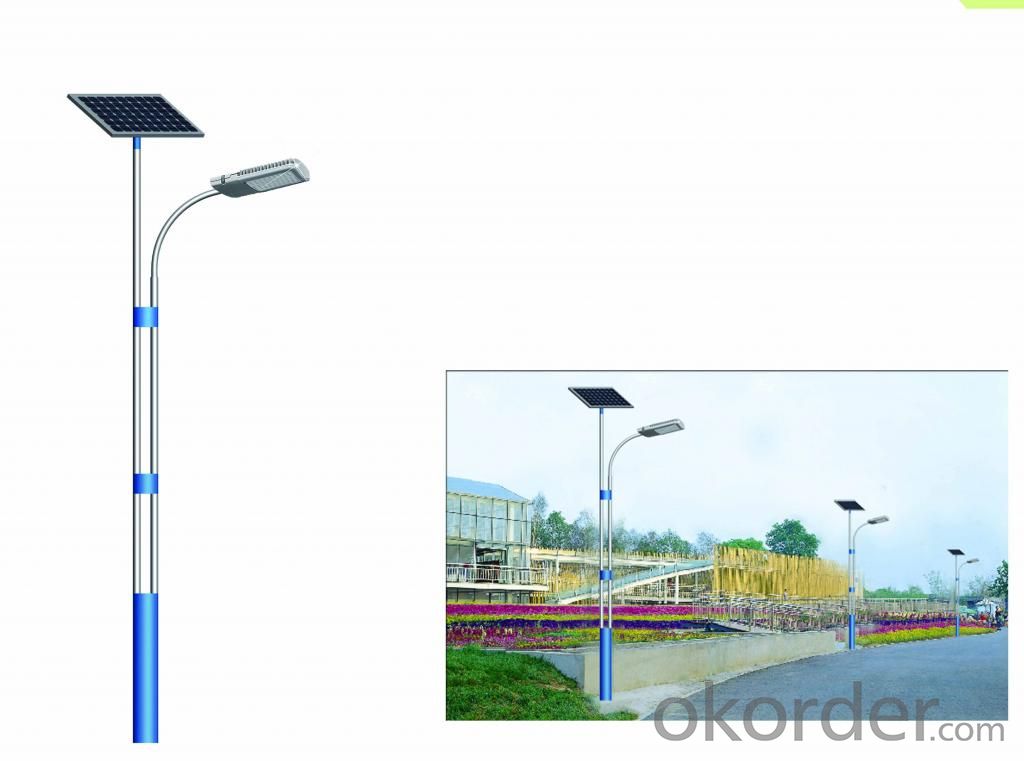
- Q:Are solar lights compatible with mobile app control?
- Yes, solar lights can be compatible with mobile app control. Many solar light manufacturers now offer models that can be controlled and monitored through a dedicated mobile app. This allows users to remotely adjust settings, set timers, and even receive notifications on their smartphones.
- Q:Can solar lights be used on flagpoles or outdoor flag displays?
- Yes, solar lights can be used on flagpoles or outdoor flag displays. In fact, they are a popular and environmentally-friendly option for illuminating flags during the night. Solar lights are designed to harness energy from the sun and convert it into electricity, which is then used to power the lights. They typically come with a small solar panel that needs to be installed in a location where it can receive direct sunlight. Once charged, solar lights can provide a steady source of illumination for several hours, depending on the specific model and the amount of sunlight received. This makes them ideal for flagpoles or outdoor flag displays as they do not require any wiring or electrical connections, making installation and maintenance hassle-free. Additionally, solar lights are often equipped with sensors that automatically turn the lights on at dusk and off at dawn, ensuring that the flag is properly illuminated throughout the night.
- Q:Are solar lights suitable for gardens?
- Yes, solar lights are suitable for gardens. They are an eco-friendly and cost-effective lighting option that can enhance the ambiance, provide safety, and highlight specific features in the garden. Additionally, they are easy to install and maintain as they do not require any wiring or electricity connection.
- Q:What is the cost of solar lights?
- The cost of solar lights can vary depending on factors such as the brand, quality, features, and where they are purchased. Generally, solar lights can range in price from around $20 for basic models to several hundred dollars for more advanced or specialized options.
- Q:Are solar lights resistant to chemicals or harsh cleaning agents?
- Solar lights are generally resistant to chemicals and harsh cleaning agents. However, it is always recommended to refer to the manufacturer's instructions for specific guidance on cleaning and maintenance to ensure the longevity and effectiveness of the lights.
- Q:Can solar lights be used for lighting up outdoor weddings or special events?
- Yes, solar lights can definitely be used for lighting up outdoor weddings or special events. In fact, they are a popular choice for such occasions. Solar lights are extremely versatile and can be easily installed without the need for electrical wiring or outlets, making them ideal for outdoor settings. They are powered by sunlight, which means they can provide continuous illumination throughout the event without the need for regular battery replacements or worrying about power sources. Solar lights are available in various designs and styles, including string lights, lanterns, spotlights, and pathway lights, allowing you to create a beautiful and enchanting atmosphere for your outdoor wedding or special event. Additionally, solar lights are energy-efficient and eco-friendly, as they do not rely on electricity from the grid, reducing your carbon footprint and helping to create a sustainable event. Overall, solar lights are a practical and aesthetically pleasing choice for lighting up outdoor weddings or special events.
- Q:Can solar lights be used for outdoor signage or banners?
- Yes, solar lights can be used for outdoor signage or banners. They offer a convenient and sustainable way to illuminate outdoor displays without the need for electrical wiring or traditional power sources. Solar lights are designed to harness and store solar energy during the day, which is then used to power the lights at night, providing a cost-effective and environmentally friendly solution for outdoor signage lighting.
- Q:How do solar lights handle power fluctuations in areas with unreliable grid electricity?
- Solar lights are designed to handle power fluctuations in areas with unreliable grid electricity in a couple of ways. Firstly, solar lights are equipped with a built-in battery that stores energy generated from the sun during the day. This battery acts as a backup power source, allowing the lights to continue functioning even during power outages or fluctuations in the grid electricity supply. Additionally, solar lights often come with features like a charge controller or voltage regulator. These devices help regulate and stabilize the power input from the solar panel to the battery, ensuring that the stored energy is efficiently utilized and protected from any sudden surges or drops in the grid electricity. This helps in maintaining a consistent and reliable power supply to the lights, even in areas with unreliable grid electricity. Furthermore, solar lights are designed to be energy-efficient, using LED technology that requires minimal power consumption while providing adequate illumination. This ensures that the solar lights can operate for longer periods on the stored energy, minimizing the impact of power fluctuations and enhancing their reliability in areas with unreliable grid electricity. Overall, solar lights are specifically designed to handle power fluctuations in areas with unreliable grid electricity by incorporating battery backup systems, voltage regulators, and energy-efficient LED technology. These features ensure that the lights continue to function reliably, providing illumination even during power outages or fluctuations, and offering a sustainable lighting solution in areas with unreliable grid electricity.
- Q:Can solar lights be used for parking lots or garages?
- Yes, solar lights can definitely be used for parking lots or garages. In fact, they are becoming increasingly popular for these applications due to their numerous benefits. Solar lights are powered by sunlight, which means they do not require any electrical wiring or connections to the grid. This makes them easy to install and eliminates the need for costly trenching or digging. Additionally, solar lights are highly energy-efficient as they convert sunlight into electricity through photovoltaic panels. They store this energy in built-in batteries during the day and use it to power the lights during the night. This not only reduces electricity costs but also helps in minimizing the carbon footprint and promoting environmental sustainability. When it comes to parking lots and garages, solar lights provide reliable illumination throughout the area. They are designed to emit bright light that ensures enhanced visibility and safety for vehicles and pedestrians. Some solar lights even come with motion sensors, which can be particularly useful in parking lots or garages to deter theft or vandalism. Moreover, solar lights offer flexibility in terms of placement. Since they are not dependent on a traditional power source, they can be installed in any location that receives sufficient sunlight, regardless of the proximity to electrical outlets. This allows for greater versatility in designing the lighting layout and ensures optimal coverage for the parking lot or garage. Overall, solar lights are a cost-effective, eco-friendly, and practical solution for lighting parking lots and garages. They offer the convenience of easy installation, energy-efficient operation, improved safety, and reduced maintenance requirements. With advancements in solar technology, these lights have become a reliable and sustainable alternative to traditional electric lighting options.
- Q:Are solar lights suitable for driveways and garages?
- Yes, solar lights are suitable for driveways and garages. They are a cost-effective and environmentally friendly option that can provide sufficient illumination for these areas. Solar lights are easy to install, require minimal maintenance, and can operate independently without the need for electrical wiring.
1. Manufacturer Overview |
|
|---|---|
| Location | |
| Year Established | |
| Annual Output Value | |
| Main Markets | |
| Company Certifications | |
2. Manufacturer Certificates |
|
|---|---|
| a) Certification Name | |
| Range | |
| Reference | |
| Validity Period | |
3. Manufacturer Capability |
|
|---|---|
| a)Trade Capacity | |
| Nearest Port | |
| Export Percentage | |
| No.of Employees in Trade Department | |
| Language Spoken: | |
| b)Factory Information | |
| Factory Size: | |
| No. of Production Lines | |
| Contract Manufacturing | |
| Product Price Range | |
Send your message to us
Solar Light Solar Product Off Grid New Energy 027ZE
- Loading Port:
- Shanghai
- Payment Terms:
- TT OR LC
- Min Order Qty:
- 1 watt
- Supply Capability:
- 5000 watt/month
OKorder Service Pledge
OKorder Financial Service
Similar products
New products
Hot products
Hot Searches
Related keywords
